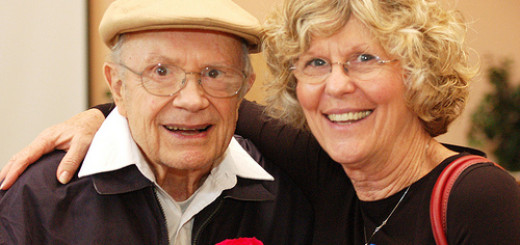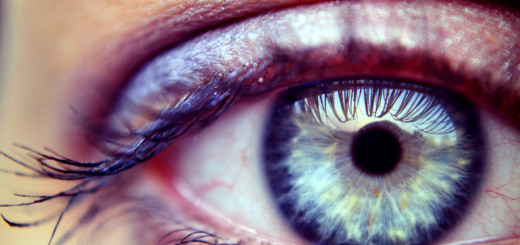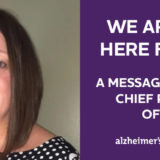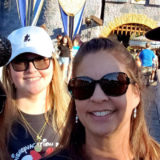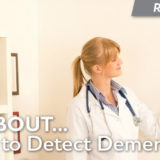Sacramento Walker encourages you to know the 10 signs
Karen Funk’s mother, who had Alzheimer’s, had been showing signs of the disease long before they received a diagnosis. The family assumed her mother’s symptoms were just a normal part of aging. After her mother’s diagnosis, Karen made it her mission to educate the community on the signs of dementia, to help others get a timely diagnosis.
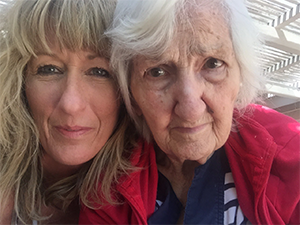
Living a busy life
Before Dorothy Rutledge, Karen’s mom, was diagnosed with Alzheimer’s, she was living a busy life. She volunteered, participating in activities such as bake sales and yard sales. She enjoyed vacations with her family. She helped her friends who could no longer drive, by taking them anywhere they needed to go.
Most notably, Dorothy was an expert at making pies. “She made all of the pies for Christmas and Thanksgiving,” said Karen. “I still can’t make a pie crust as well as she could, and I never will.”
When her husband died, Dorothy moved to a senior living facility in downtown Sacramento. She began watching Karen’s children, who were then one and five, while Karen was at work. Karen and her mom spent the next 15 years bonding over sewing and baking.
Missing the signs
While Karen and her family knew of Alzheimer’s disease, they were unaware of what signs to look for. When her mother began to show some of the signs associated with Alzheimer’s or other dementias, Karen and her family brushed it off as old age, thinking it was just normal forgetfulness.
Here are some of the warning signs of Alzheimer’s that Dorothy was exhibiting:
- Memory loss that disrupts daily life.
Karen’s mom began to complain every day of not feeling well and didn’t want to get out of bed. “I started to look at her blood pressure medication,” said Karen. “It was the only medication she was on and she was going through them quickly. It turned out, Mom kept forgetting that she had already taken her medication for the day and would take another. I just assumed she was being forgetful and bought her a pill case.” - Confusion with time or place.
Dorothy lived 20 minutes away from Karen’s house, where she visited often. She got lost on the way to Karen’s. “I told myself it was an easy mistake,” Karen recalled, “and that she must have gotten turned around.” - Challenges in planning or solving problems.
With the pie recipes tucked in her head, Dorothy made all of her pies from memory. One year for Christmas, the pies looked the picture of perfection. Karen says, “When we started to eat them, we realized she had forgotten to add any sugar!” - New problems with words in speaking or writing
When Karen and her mom were on a cruise, Dorothy fell in the shower, hurting her back. “She kept trying to explain what hurt,” said Karen. “She couldn’t tell us what was wrong. After several visits to the doctor and a physical therapist, it turned out she had a fractured disc that had compressed.” - Misplacing things and losing the ability to retrace your steps.
One day, Dorothy parked the car and couldn’t remember where she left it. Karen said, “It took us a week to find her car. We wouldn’t let Mom drive after that.” - Decreased or poor judgement.
Karen noticed that her mom was missing money. She began to monitor her Dorothy’s bank account. Her mom had been giving money to a family member she normally wouldn’t have supported. “Mom forgot their history,” shared Karen. “I just assumed this person had become better at convincing Mom to give them money.”
Getting a diagnosis
It wasn’t until Dorothy went missing that Karen understood that there was a bigger problem. Dorothy had left her phone at home while she spent eight hours riding the city bus before she found her own way home.
After this incident, Karen and her family reached out to their mom’s senior living facility. “We talked to the management at the facility and found out there were a lot of other things she was doing we didn’t know about,” said Karen. “She was going into other people’s homes and putting on their clothes. She’d walk around with 10 layers of tops on.”
The facility informed Karen and her family that their mother was showing signs of Alzheimer’s.
“We took her to the doctor,” said Karen. “We needed to know what was going on.” In 2013, Dorothy was diagnosed with Alzheimer’s.
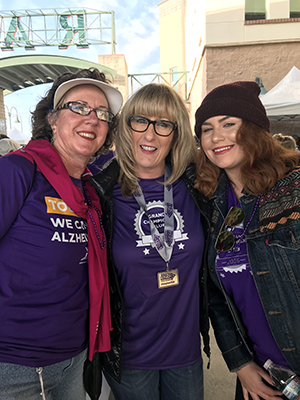
The importance of knowing the signs
Karen wants everyone to know the 10 warning signs of Alzheimer’s. “I was appalled at how many medical professionals didn’t know the signs,” said Karen. “Imagine if the bus drivers had known the signs when my mom was still on the bus several hours later.
“Looking back, I can see all the signs we missed. Had we known the 10 warning signs, we could have made a plan, but instead we had to play catch up. I thought I had full power of attorney, but I only had medical. By the time we had a diagnosis, they wouldn’t accept a newly formed document. Luckily, I already had access to all of her bank accounts.
“When you see a red heart, you know the signs for a heart attack. When you see the pink ribbon, you know to get a mammogram. I want people to look at the purple arrow [on the Walk to End Alzheimer’s logo] and know the 10 warning signs.”
Her personal mission
When Karen first began this journey with her mom, she started posting photos on Facebook whenever she’d go and visit her. “My mom has family back east who can’t visit. I’d post photos of my mom from whatever happened that day. It could be something about her not remembering her birthday or whether it was a good or bad day.
“When the long goodbye became the last good-bye, I posted that on Facebook. I was surprised by how many people reached out. I had no idea how many people I’d touched. I received comments thanking me because other people knew they weren’t alone on their journey.
“It was these comments that made me understand that this is my mission. I have to be the voice for people out there who feel like they don’t have one.”
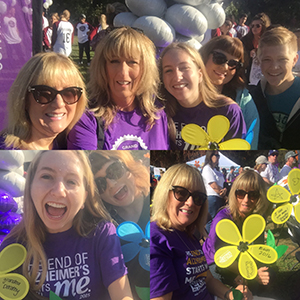
Supporting the Alzheimer’s Association
According to the Alzheimer’s Association 2020 Alzheimer’s Disease Facts and Figures report more than five million American’s are living with Alzheimer’s disease. It’s currently the third leading cause of death in California and the sixth in the United States. In 2020, Alzheimer’s and other dementias will cost the nation over $305 billion in healthcare costs.
These statistics are part of what motivates Karen to raise awareness of the Alzheimer’s Association. Karen says, “Families are spending all of their finances to provide care for their loved one.
“We need to get the word out about the Alzheimer’s Association and its services. The 24/7 Helpline (800.272.3900) helped me find adult day care services and a care facility for my mom.
“I want people to know that the Alzheimer’s Association is here for you. I can’t tell you how many times the Helpline talked me off a ledge. They gave me great tips to try and they usually worked.
“I want people to know the 10 warning signs so they can get an early diagnosis. There are so many more services and options available once you have a diagnosis. The Alzheimer’s Association wants to talk to you. We’ve all been there, and there is nothing you can tell them that would shock them.”
Join the Walk Committee
In 2015, a few years after her mother was diagnosed, Karen decided to participate in Walk to End Alzheimer’s in Chico. Her daughter was attending school there and they were able to walk together to honor Dorothy.
Two years after that, in 2017, she began participating in the Sacramento Walk to End Alzheimer’s, which was closer to her home. The Walk Manager, Stephanie Cardenas, reached out to Karen and asked her to join the Walk Committee.
Karen agreed and her first year on the committee, she helped with whatever was needed. This year, Stephanie asked her to become Mission Chair for the 2020 Walk. Karen is honored to hold such an important role.
“Now that I’m the Mission Chair, I love being able to be creative and share my story,” said Karen. “I get to come up with creative ways to get the word out about Alzheimer’s.

“I have a wooden board that is shaped like an arrow and I painted it purple. The first person who joined my committee signed it. Once the pandemic is over, I’m going to take that arrow everywhere I go.”
Staying busy during COVID
While the world shifted to working for home, Walk to End Alzheimer’s Committee members continued to meet and plan for the upcoming Walk season. They called hundreds of Walkers, past and present, to check-in on them and make sure their families were healthy and safe. They offered support where they could.
“We wrote handwritten cards to past Walkers,” said Karen. “Stephanie sent me everything I needed. We thanked them for raising funds and let them know how their fundraising dollars were used for care support and research. I also reminded them that the Alzheimer’s Association is available online and by phone.”
Karen and the committee have also spent this time creating a cookbook. It’s filled with the committee members’ favorite recipes from their loved ones who have or had dementia. Of course, it also includes information on the 10 warning signs.
Walk this year
With social distancing in full force, the Walk to End Alzheimer’s is asking all walkers to stay close to home and walk within their local communities. “I’m very excited about Walk this year,” said Karen.
“I love that we’ll have flags to put in our windows and a view-only Promise Garden for people to see. I think that we’ll reach a wider audience now that we’re walking in our communities.”
Karen and the committee are encouraging people to continue to participate in Walk this year. They want to make sure their communities know that they are not alone, and the Alzheimer’s Association is still here for them.
The Sacramento Walk Committee has shared videos on why they Walk, which can be viewed on their Facebook group. If you’d like to share why you walk fill out our Why I Walk form here.
You can join Karen’s team, Funksters or form your own team and join us for Sacramento Walk on September 26. We’re still coming together in 2020, even if it means trying something new. Not in Sacramento? Register today at alz.org/walk and be the first to know about Walk in your area.
Learn more:





